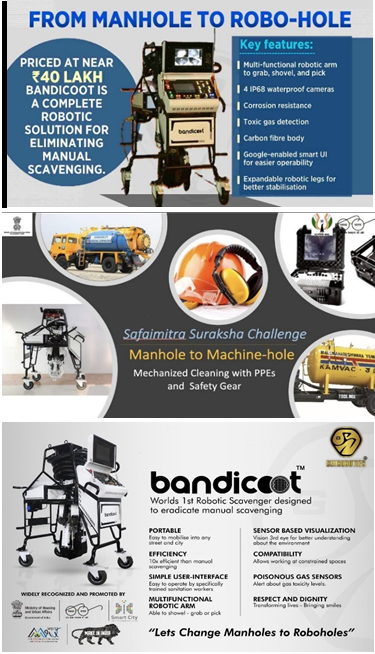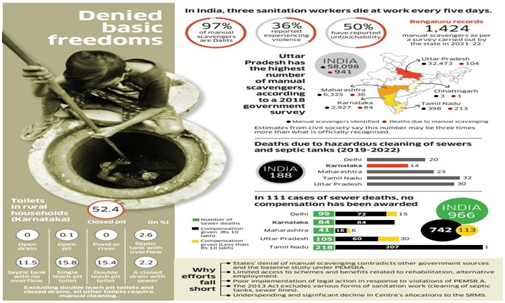Manual Scavenging


Manual Scavenging
Current Affairs Daily News & Issues
La Excellence IAS Academy | October 21, 2023
Syllabus: GS Paper-II.
Sub topic: Government Policies & Interventions. Issues related to SCs & STs
Tags: # zero Manual Scavenging #Sc’s#Dalits#SC verdict # Article17#
Why in the news?
Completely Eradicate Manual Scavenging: SC Directs Centre, States.
Increases Compensation to Rs 30 Lakh
Issue: As many as 347 people died while cleaning sewers and septic tanks in India in the last five years with Uttar Pradesh, Tamil Nadu, and Delhi accounting for 40 percent of these deaths.
What is Manual scavenging?


The term ‘manual scavenging’ symbolizes the practice that includes manually carrying human excreta.
Earlier it referred to the practice of removing the excreta from dry latrines, but with the invention of modern sanitation technologies, new forms of manual scavenging works have evolved which include the manual cleaning of drains, septic tanks as well as sewer lines and latrine pits.
Who is doing manual scavenging in India?
The report presented in oxfamindia.org The International Dalit Solidarity Network claims that 1.3 million people in India, mostly women are involved in manual scavenging of which 99% are Dalit’s among 95% are women. Report’s Source on Oxfam India.
· People who work as manual scavengers belong to caste groups which belong to the lowest level of the caste hierarchy in India.
- Occupations that are designated to people based on their castes have fortified the previously existing social stigma making people of lower castes ‘dirty’ and ‘untouchable’.
- Women are usually assigned with cleaning dry toilets, while men are designated with work that is physically demanding like cleaning septic tanks and sewers.
Supreme Court’s Verdict:
Dr.Balram Singh v. Union of India:
- Government authorities will pay Rs 30 lakh as compensation to the kin of those who die while cleaning sewers.
- who suffer permanent disabilities while cleaning sewers will be paid Rs 20 lakh as minimum compensation
- The authorities will have to pay up to Rs 10 lakh if the cleaner suffers other disabilities.
The bench noted that the battle against manual scavenging is not merely about wealth, but about human dignity. The commitment constitution makers gave – each of us must live up to this, and Union and states must ensure that manual scavenging is completely eradicated, and this stops where these people remain trapped in human sufferings,”
Constitutional & Human Rights Guarantees:
- Articles 1, 22, and 23 of the Universal Declaration of Human Rights. ‘Dignity’ has been construed to include equal treatment and protection of the law, and equal respect.
- The following is a list of provisions under the Indian Constitution which is supposed to cater to the rights of equality, respect, and dignity before the law.
- Human dignity is an inalienable right that forms a part of the fundamental right to life (Article 21– Maneka Gandhi vs. Union of India) as per the Constitution of India.
- Article 14 is about equality before the law which should not be denied to any individual in India.
- Article 15 provides that no discrimination is permitted based on the place of birth of a person, race, religion, caste, and sex. Manual scavengers, however, face discrimination because of their caste all their lives.
- Article 16 of the Indian Constitution, in matters of public employment guarantees equal opportunity to all its citizens.
- Article 17 has a provision for the abolition of untouchability, it is guaranteed under this constitutional provision to all.
- Article 19(1)(g) gives every citizen the right to practice any profession or to carry on any occupation, trade, or business of their choosing.
- Article 21 guarantees the protection of life and personal liberty to all the citizens living in India.
- Article 46 and Article 338 other rights that safeguard the manual scavengers as SC or ST, under the Indian Constitution.
Key milestones in the efforts to eliminate manual scavenging in India:
- 1955: The Protection of Civil Rights Act called for the abolition of scavenging on untouchability grounds.
- 1977: The Act was revised for stricter implementation.
- 1980-81: The Integrated Low-Cost Sanitation Scheme aimed to convert dry toilets into pit toilets.
- 1989: The Prevention of Atrocities Act provided protection to sanitation workers, particularly those from Scheduled Castes.
- 1993: The Employment of Manual Scavengers and Construction of Dry Latrines (Prohibition) Act took a stricter stance against employing manual scavengers.
- 1994: The National Commission for Safai Karamcharis (NCSK) was established to address issues related to sanitation workers.
- 2000: NCSK reported a gap in implementing the 1993 Act.
- 2002: The Ministry of Social Justice and Empowerment reported over 79 million people engaged in manual scavenging.
- 2003: The CAG’s report indicated that the 1993 Act had not achieved its objectives despite substantial investments.
- 2007: The NHRC called for national adoption of the 1993 Act by all states.
- 2013: The Parliament passed the Prohibition of Employment as Manual Scavengers Act, 2013, with a focus on rehabilitation.
- 2020: The Prohibition of Employment as Manual Scavengers and their Rehabilitation (Amendment) Bill, 2020.
- It proposes to completely mechanize sewer cleaning, introduce ways for ‘on-site’ protection, and provide compensation to manual scavengers in case of sewer deaths.
- It will be an amendment to The Prohibition of Employment as Manual Scavengers and their Rehabilitation Act, 2013.
- It is still awaiting cabinet approval.
- 2021: The Indian government announced a slew of measures under the Swachh Bharat Abhiyaan(Clean India initiative) to end the discriminatory and hazardous practice of manual scavenging .
- Mechanization of sewer cleaning has been proposed as a solution since as early as 1956.
- Numerous committees and commissions have made recommendations to improve the lives of manual scavengers.
- Despite various policy and legal frameworks, the problem persists due to implementation challenges on the ground.
The Prohibition of Employment as Manual Scavengers and their Rehabilitation Act, 2013.
This act prohibits manual scavenging, insanitary latrine construction and maintenance, and dangerous cleaning of septic tanks or sewers.
Key highlights of the Act include:
- Offenses under the Act are non-bail able and fall under court jurisdiction.
- The Act mandates a time-bound survey of manual scavengers in both urban and rural areas.
- It requires comprehensive rehabilitation, including photo ID cards, initial cash assistance, scholarships for scavengers’ children, residential plots or houses, concessional loans, and legal/programmatic support.
- The Act establishes a monitoring mechanism for oversight.
Despite these legal provisions, manual scavenging persists in India due to various challenges.
- Women who attempt to leave this profession often face threats from the households they serve, with little intervention from local authorities.
- Denial of community resources, eviction threats, and non-compliance with laws by panchayats and municipal corporations contribute to the persistence of this practice.
- Manual scavengers struggle to receive fair wages and face health issues due to inadequate sanitary protection, perpetuating the social stigma surrounding their work.

PLIGHT OF SANITATION WORKERS FROM THE LENS OF SDGs


India is a signatory to the 2030 agenda for Sustainable Development. Yet the prevalence of manual scavenging in the country undermines the achievement of




Sustainable Development Goals (SDGs)
- clean water and sanitation (Goal 6).
- Decent work and economic growth (Goal 8).
- Reduced inequalities (Goal 10), and
- Peace, justice and strong institutions (Goal 16).
The Danish Institute for Human Rights notes that 156 of the 169 targets defined under the SDGs are linked to human rights and labour standards10, underscoring the importance of measuring progress of excluded communities and rights-holders such as those engaged in manual scavenging and sanitation work
Zero Manual Scavenging In India?
Despite strict laws, manual scavenging remains widespread in India, perpetuating caste and class divides.
Workers cleaning septic tanks and sewers face life-threatening risks and suffer from various health disorders.
Manual scavenging deaths increased significantly in recent years, with 2019 reporting the highest number in five years—110 fatalities, a 61% rise compared to 2018. A national survey identified 48,345 manual scavengers in 18 states as of January 31, 2020.
Uttar Pradesh had the highest number of manual scavengers, with over 29,000 workers in 2018.
Tamil Nadu has the highest numbers in 2020.
Technological Advancements to Zero Manual Scavenging :
- Robotic system is valuable because often accidents occur when people enter manholes. If the current rollout is smooth, the government plans to expand its deployment as it will prevent accidents and deaths and instill confidence in our workers.
- Bandicoot, with its robotic arms, could clear clogged manholes and sewerages, which were earlier done by manual labourers using their bare hands.


KEY RECOMMENDATIONS
- Abolish by law any direct contact
between human beings and faecal as well as sewage matter
- Ensure rehabilitation of the manual scavenging community, and providing good quality education to children to enable them to avail alternative livelihood options, thereby preventing the next generation from engaging in this inhuman practice
- Revise building bye-laws to ensure that buildings of a particular size have mandatory decentralised wastewater management systems
- Identify and map different forms of sanitation work and workers; incentivise officials to undertake such mapping and make them culpable on failing to do so
- Explore technology-centred alternatives to reduce the risks associated with sanitation work
- Ensure social security provisions like pensions for sanitation workers, especially female manual scavengers (not as an entrepreneurial support but as a regular income)
- Build public consciousness around the issue of manual scavenging and rights of sanitation worker


Leave a Reply
You must be logged in to post a comment.
